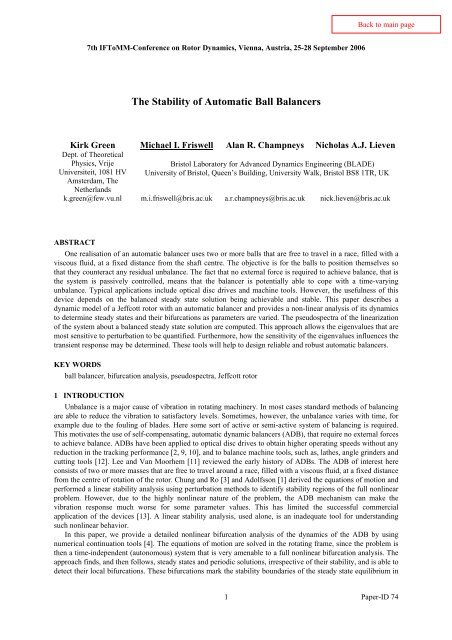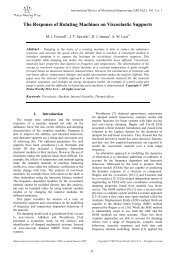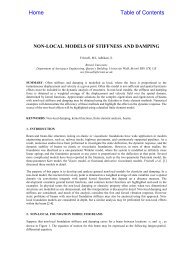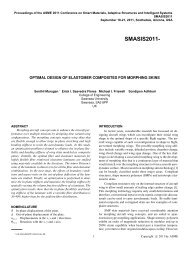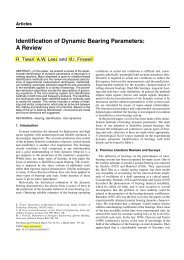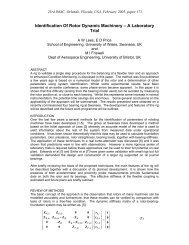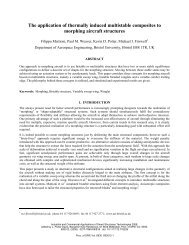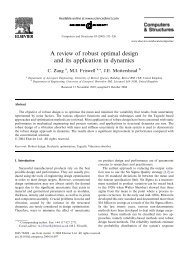The Stability of Automatic Ball Balancers (Paper ... - Michael I Friswell
The Stability of Automatic Ball Balancers (Paper ... - Michael I Friswell
The Stability of Automatic Ball Balancers (Paper ... - Michael I Friswell
You also want an ePaper? Increase the reach of your titles
YUMPU automatically turns print PDFs into web optimized ePapers that Google loves.
7th IFToMM-Conference on Rotor Dynamics, Vienna, Austria, 25-28 September 2006<strong>The</strong> <strong>Stability</strong> <strong>of</strong> <strong>Automatic</strong> <strong>Ball</strong> <strong>Balancers</strong>Kirk Green <strong>Michael</strong> I. <strong>Friswell</strong> Alan R. Champneys Nicholas A.J. LievenDept. <strong>of</strong> <strong>The</strong>oreticalPhysics, VrijeUniversiteit, 1081 HVBristol Laboratory for Advanced Dynamics Engineering (BLADE)University <strong>of</strong> Bristol, Queen’s Building, University Walk, Bristol BS8 1TR, UKAmsterdam, <strong>The</strong>Netherlandsk.green@few.vu.nl m.i.friswell@bris.ac.uk a.r.champneys@bris.ac.uk nick.lieven@bris.ac.ukABSTRACTOne realisation <strong>of</strong> an automatic balancer uses two or more balls that are free to travel in a race, filled with aviscous fluid, at a fixed distance from the shaft centre. <strong>The</strong> objective is for the balls to position themselves sothat they counteract any residual unbalance. <strong>The</strong> fact that no external force is required to achieve balance, that isthe system is passively controlled, means that the balancer is potentially able to cope with a time-varyingunbalance. Typical applications include optical disc drives and machine tools. However, the usefulness <strong>of</strong> thisdevice depends on the balanced steady state solution being achievable and stable. This paper describes adynamic model <strong>of</strong> a Jeffcott rotor with an automatic balancer and provides a non-linear analysis <strong>of</strong> its dynamicsto determine steady states and their bifurcations as parameters are varied. <strong>The</strong> pseudospectra <strong>of</strong> the linearization<strong>of</strong> the system about a balanced steady state solution are computed. This approach allows the eigenvalues that aremost sensitive to perturbation to be quantified. Furthermore, how the sensitivity <strong>of</strong> the eigenvalues influences thetransient response may be determined. <strong>The</strong>se tools will help to design reliable and robust automatic balancers.KEY WORDSball balancer, bifurcation analysis, pseudospectra, Jeffcott rotor1 INTRODUCTIONUnbalance is a major cause <strong>of</strong> vibration in rotating machinery. In most cases standard methods <strong>of</strong> balancingare able to reduce the vibration to satisfactory levels. Sometimes, however, the unbalance varies with time, forexample due to the fouling <strong>of</strong> blades. Here some sort <strong>of</strong> active or semi-active system <strong>of</strong> balancing is required.This motivates the use <strong>of</strong> self-compensating, automatic dynamic balancers (ADB), that require no external forcesto achieve balance. ADBs have been applied to optical disc drives to obtain higher operating speeds without anyreduction in the tracking performance [2, 9, 10], and to balance machine tools, such as, lathes, angle grinders andcutting tools [12]. Lee and Van Moorhem [11] reviewed the early history <strong>of</strong> ADBs. <strong>The</strong> ADB <strong>of</strong> interest hereconsists <strong>of</strong> two or more masses that are free to travel around a race, filled with a viscous fluid, at a fixed distancefrom the centre <strong>of</strong> rotation <strong>of</strong> the rotor. Chung and Ro [3] and Adolfsson [1] derived the equations <strong>of</strong> motion andperformed a linear stability analysis using perturbation methods to identify stability regions <strong>of</strong> the full nonlinearproblem. However, due to the highly nonlinear nature <strong>of</strong> the problem, the ADB mechanism can make thevibration response much worse for some parameter values. This has limited the successful commercialapplication <strong>of</strong> the devices [13]. A linear stability analysis, used alone, is an inadequate tool for understandingsuch nonlinear behavior.In this paper, we provide a detailed nonlinear bifurcation analysis <strong>of</strong> the dynamics <strong>of</strong> the ADB by usingnumerical continuation tools [4]. <strong>The</strong> equations <strong>of</strong> motion are solved in the rotating frame, since the problem isthen a time-independent (autonomous) system that is very amenable to a full nonlinear bifurcation analysis. <strong>The</strong>approach finds, and then follows, steady states and periodic solutions, irrespective <strong>of</strong> their stability, and is able todetect their local bifurcations. <strong>The</strong>se bifurcations mark the stability boundaries <strong>of</strong> the steady state equilibrium in1 <strong>Paper</strong>-ID 74
the full nonlinear system [5]. We also consider the transient response <strong>of</strong> a machine fitted with an ADBmechanism. <strong>The</strong> transient behavior in linear dynamical systems can be very different to that predicted by a linearstability analysis, where the eigenvalues determine the asymptotic behavior. Often, in stable non-normalsystems, transients may exhibit an undesired dynamic response, such as, a large transient growth (or apparentinstability) preceding a long, highly oscillatory, exponential decay or, alternatively, a rapid collapse beforeeventual asymptotic decay to the stable equilibrium [6]. This behavior is <strong>of</strong> particular concern when consideringa linearization about an equilibrium <strong>of</strong> a system with strong nonlinearities. In this case, a large transient growthmay result in a trajectory <strong>of</strong> the full nonlinear system coming close to regions <strong>of</strong> state space where thelinearization breaks down. Thus the eigenvalues <strong>of</strong> the linearization do not always correctly predict the behavior<strong>of</strong> the full nonlinear system, particularly in a finite time interval [8]. Hence an analysis and understanding <strong>of</strong> thesensitivity to perturbation and the ensuing transient response is necessary for the robust design <strong>of</strong> a practicaldevice.2 EQUATIONS OF MOTIONFigure 1 shows a schematic <strong>of</strong> an ADB with two balancing masses. Movement is confined to the planardirections X and Y. <strong>The</strong> equations <strong>of</strong> motion describing this system are derived using Lagrange’s equation [5].<strong>The</strong> equations describing the displacement in the X and Y directions are given by2MX + c X + k X −M εψ cos ψ−MεψsinψX Xn∑ i i i i ii=12{ ( ) ( ) ( ) ( )}+ m X −R ψ + φ sin ψ+ φ − R ψ + φ cos ψ+ φ = 0n2MY + cYY + kYY −M εψ sin ψ+ M εψcosψ+ Mg + ∑ migi=1n(2)2+ ∑ mi{ Y + R( ψ+φ i) cos( ψ+φi) −R( ψ+φ i) sin ( ψ+φ i)} = 0i=1where ψ is the angular position <strong>of</strong> the rotor. Finally, the equation <strong>of</strong> motion <strong>of</strong> the ith ball is given by2−mR i ⎡X sin ( ψ+φi) −Y ⎣cos ( ψ+φ i) ⎤⎦+ mR i ( ψ+φ i) + Diφ i + mgR i cos( ψ+φ i)= 0 . (3)<strong>The</strong>se equations can be simplified by assuming equal masses m <strong>of</strong> the balancing balls, an equal viscous dragforce D acting on each ball, a constant angular velocity <strong>of</strong> the rotor ω ( ψ =ω t ) , and isotropic suspension <strong>of</strong> therotor c (damping constant) and k (spring constant). Finally, we neglect the effect <strong>of</strong> gravity on the motion <strong>of</strong> theballs, that is we set g=0.Furthermore, we can write the equations in dimensionless form by introducing the following nondimensionalstatesX YX = , Y , t nt,R= R=ω (4)and the dimensionless parametersω m ε c DΩ= , µ= , δ= , ς= , β= .ω22n M R kM mR ωnwhere ω n = k/M is the natural frequency <strong>of</strong> the rotor.Finally, we obtain a time independent set <strong>of</strong> equations by transforming to a rotating frame <strong>of</strong> reference, using( ) ( ) ( ) ( )X = xcos Ωt − ysin Ω t , Y = xsin Ω t + ycosΩ t . (6)This results in the following second-order dimensionless system describing the ADB in the rotating frame:(1)(5)2 <strong>Paper</strong>-ID 74
( n )⎛1+ nµ 0 ⎞⎛x⎞ ⎛ 2ς −2Ω 1+ µ ⎞⎛x⎞ ⎛ K −2Ως⎞⎛x⎞⎜ ⎟⎜ ⎟+ ⎜⎟⎜ ⎟+⎜ ⎟⎜ ⎟⎝ 0 1+ nµ ⎠⎝y⎠ ⎝2Ω ( 1+ nµ ) 2ς⎠⎝y⎠ ⎝2ΩςK ⎠⎝y⎠( Ω+φ)22 n ⎛⎞⎛ ⎞δΩ ⎜ i φi ⎟⎛cosφi⎞= +µ,⎜ 0 ⎟ ∑2 ⎟⎜ ⎟⎝ ⎠sini=1⎜ φ−φ ii ( Ω + φi)⎟⎝ ⎠⎝⎠(7)2 2( x x y) ( y y x) φ i +βφ i = −Ω −2Ω sinφi − −Ω + 2Ωcos φi.In this paper, we consider two balancing masses, that is, n = 2 . <strong>The</strong>refore, our system describing the ADB,when written as a system <strong>of</strong> first-order equations, is eight-dimensional. This system has three steady statesolutions. Namely, a balanced steady state where the radial vibration is reduced to zero; a ‘coincident’ steadystate where the balls occupy the same position in the race, resulting in a non-zero radial vibration; and an ‘inline’steady state where the two balls lie on opposite sides <strong>of</strong> the race in a line with the centre <strong>of</strong> mass <strong>of</strong> therotor [5]. Here, we concentrate on the balanced steady state solution given by,x = y = 0 ,−1⎛−δ⎞φ 1 = cos ⎜ ⎟⎝2µ⎠ , φ 2 =−φ 1. (8)A conclusion we can immediately make for the balanced steady state to exist is that, 2µ>δ. In words, thebalancing balls must have a large enough mass (with respect to the mass <strong>of</strong> the rotor) in order to overcome themass eccentricity (or equivalently the residual unbalance).Yφ 1mφ 2k XDRC RC M00 1100 11M00 11ɛψc Xk Yc Y0Figure 1: <strong>Automatic</strong> dynamic balancer.X3 BIFURCATION ANALYSISBifurcation analysis is used to ‘map’ out how the stability <strong>of</strong> a system depends on changes in its parameters.We use the numerical continuation package AUTO [4] to investigate the stability <strong>of</strong> the steady states detailedabove as the dimensionless parameters for the mass µ, eccentricity δ, external damping ζ , and internal dampingβ are varied. Figure 2 shows the stability regions in ( Ω , µ ) -space (a), ( Ω,δ)-space (b), ( Ως , )-space (c), and( Ωβ , )-space (d). In each case, when fixed, the other parameters are µ = 0.05, β = δ = ζ = 0.01. Dark shadedregions in Fig. 2 correspond to parameter values where the balanced state is stable. Lighter regions correspond toparameter values where the coincident equilibrium is stable. No shading corresponds to regions <strong>of</strong> instability.Dashed curves indicate lines <strong>of</strong> Hopf bifurcations, marked by a H. In other words, crossing one <strong>of</strong> these curves,due to the variation in the parameters, will result in an oscillatory instability. In particular, the Hopf curvesbordering the regions with dark shading result in an oscillatory instability <strong>of</strong> the stable balanced state and a3 <strong>Paper</strong>-ID 74
subsequent stable periodic solution. <strong>The</strong> solid curves indicated in Fig. 2, labeled SN, indicate lines <strong>of</strong> saddlenodebifurcations. As a line <strong>of</strong> saddle-node bifurcations is crossed a coincident equilibrium is born (whencrossing into the light shaded region) or destroyed (when crossing into a region <strong>of</strong> instability). Finally, the curvein Fig. 2(a) marked PF indicates a line <strong>of</strong> pitch-fork bifurcations in which an additional steady state is born ordestroyed. For example, as µ is increased from zero, the balanced state is born at the curve PF. This balancedstate, born at PF, is unstable for Ω< 1.3 but stable otherwise, that is, crossing from the light shaded region tothe dark shaded region for large values <strong>of</strong> Ω.0.08µ0.06H 1(a)H 2 + H 1PF 1,2 +0.1δ(b)H 1H 10.04SN 2 ±0.050.02SN 2 ±SN 2 ± SN 2 ±PF 1,2 −H 100.5 1 1.5 2 2.5Ω00 1 2 3Ω0.5(c)0.5(d)ζβH 1H 10 1 2 3H 10.250.25SN 2 ± SN 2 ±SN 2 ±SN 2 ±H 1000 1 2 3ΩΩFigure 2: Two-parameter bifurcation diagrams showing regions <strong>of</strong> stability in parameter space <strong>of</strong> the balancedsteady state (dark shading), and the coincident steady state (light shading); see text for full details.A main conclusion to be drawn from Fig. 2 is that for rotation speeds <strong>of</strong> approximately Ω> 2.5 the balancedstate is always achievable. Furthermore, Fig. 2(a) shows a ‘wedge’ <strong>of</strong> stability <strong>of</strong> the balanced state for Ω = 1,the rotation speed corresponding to the first resonant frequency ω n . This is the rotation speed at which oneobserves greatest radial vibration in a standard eccentric (Jeffcott) rotor. <strong>The</strong> fact that balance may be achievablefor rotation speeds at and close to the resonant frequency ω n is <strong>of</strong> great physical interest.However, we must note that the ADB is highly nonlinear. This has the consequence that while a balancedsteady state may be achievable, it may not be the unique solution. As an example, Fig. 3 shows three coexistingsolutions for Ω= 4 , µ = 0.05 , δ = 0.01 , ζ = 0.01 and β = 0.01. Figure 3(a) shows the dynamics <strong>of</strong> the rotorwith the ADB, as a black trajectory, for initial conditions x( 0) = x( 0) = y( 0) = y ( 0)= 0, φ 1( 0) = φ 2( 0)= 0and φ ( 0) = − φ ( 0)= π 2. <strong>The</strong> ADB is shown to balance the eccentric rotor, that is, the vibration1 22 2r= x + y is seen to go to zero. For comparison, the grey trajectory shows the dynamics <strong>of</strong> the eccentricrotor without the ADB. However, two more dynamic responses can also be observed for the same parametervalues. <strong>The</strong>se are shown in Figs. 3(b) and (c). In both cases, the attracting dynamics is a periodic oscillation <strong>of</strong>the rotor with the ADB. This results in a greater vibration than the rotor without the ADB. To obtain Figs. 3(b)4 <strong>Paper</strong>-ID 74
ε( A) { z ( A E): E }Λ = ∈Λ + ≤εwhere Λ is the spectrum (set <strong>of</strong> eigenvalues) <strong>of</strong> A+E.Figure 4 shows the ε-pseudospectra <strong>of</strong> the balanced steady state computed using the Matlab package EIG-TOOL [16]. Parameters were fixed at µ = 0.05, δ=ς = β = 0.01 , and from Fig. 4(a) to (d) the rotation speedΩ= 2.5, 3.0, 3.5, 4.0 , respectively. From outermost to innermost, the contours shown in each panel <strong>of</strong> Fig. 40 1correspond to ε-pseudospectra for ε= 10 , 10 − 2, 10 − 3, and 10 − . <strong>The</strong>se contours are centered around theeigenvalues, indicated by a black dot. Note that the linearized system is eight-dimensional, the additional foureigenvalues and corresponding pseudospectra are symmetric counterparts <strong>of</strong> those shown for I ( z) > 0. <strong>The</strong>smallest value <strong>of</strong> ε for which a contour touches the imaginary axis is also known as the stability radius <strong>of</strong> thelinearized system. From Fig. 4(a) to (d) the stability radii are given by ε= 1.32075× 10 −3 , ε= 1.64948× 10 −3 ,ε= 1.40770× 10 −3 , and ε= 1.076729× 10 −3 . <strong>The</strong> first three <strong>of</strong> these correspond to pseudospectra contourssurrounding the eigenvalue closest to the real axis. However, in Fig. 4(d) the stability radius is given by thepseudospectra contour surrounding the third eigenvalue from the real axis. In other words, as the rotation speedΩ is increased, the eigenvalue most sensitive to perturbation changes from being the one with least imaginarypart to being one with a large imaginary part. Furthermore, the order <strong>of</strong> the sensitivity <strong>of</strong> the other eigenvaluesalso changes [6]. This change in sensitivity affects the transient dynamics <strong>of</strong> trajectories <strong>of</strong> the system as thesteady state is approached.I(z)0(a)I(z)0(b)−2−2−4−4−6−6−1 0 R(z) 1−1 0 R(z) 1I(z)0−2(c)0(d)I(z)−2−4−4−6−6−1 0 R(z) 1−1 0 R(z) 1Figure 4: Pseudospectra <strong>of</strong> the balanced steady state <strong>of</strong> the linearized system describing the ADB; see text forfull details.6 <strong>Paper</strong>-ID 74
Figure 5 shows transient dynamics <strong>of</strong> the norm <strong>of</strong> the matrix exponentialAte <strong>of</strong> the linearized system A(around the balanced steady state solution) for parameter values corresponding to those used in Fig. 4. In eachpanel a large transient growth is observed which decays to the stable, balanced steady state solution. <strong>The</strong>pseudospectra <strong>of</strong> Fig. 4 give us a lower bound on the size <strong>of</strong> this transient growth. Specifically, if an ε-pseudospectra contour stretches a distance η into the right-half complex plane, a lower bound on the size <strong>of</strong> thetransient growth is given by η/ε . In other words, as the system becomes more non-normal, one observes alarger transient growth. This is evident in Fig. 5 where an increase in rotation speed Ω (which increases the nonnormality<strong>of</strong> the system) is shown to lead to an increase in the initial transient growth. Furthermore, fromFig. 5(a) to (d) the transient is seen to undergo oscillatory decay at differing frequencies. <strong>The</strong> frequency <strong>of</strong> thisdecay is directly related to the sensitivity <strong>of</strong> the eigenvalues, identified above. Specifically, as the rotation speed20‖e At ‖(a)1000 250 500 750 t 100020‖e At ‖(b)1000 250 500 750 t 100020‖e At ‖(c)1000 250 500 750 t 100020‖e At ‖(d)1000 250 500 750 t 1000Figure 5: Transient behaviour <strong>of</strong> the norm <strong>of</strong> the matrix exponential <strong>of</strong> the linearized system describing theADB.7 <strong>Paper</strong>-ID 74
Ω is increased the eigenvalues most sensitive to perturbation change from those with small imaginary part tothose with large imaginary part. Moreover, this leads to a change from transient dynamics which exhibit a slowfrequency response to transient dynamics which exhibit rapid, high frequency oscillations. Note that the mostsensitive eigenvalue need not be the rightmost, which for our system is the eigenvalue with least imaginary part.Hence, unlike for normal systems, the transient dynamics do not decay at a rate defined by the real part <strong>of</strong> therightmost eigenvalue but, if it is more sensitive, may decay at a rate defined by the leftmost eigenvalue; seeFig. 5(d). In [6] it is shown that increasing the rotation speed Ω further results in larger transient growths andhigher frequency oscillations to the balanced state. Furthermore, in [6] we show how this transient growth anddecay is directly related to the dynamics <strong>of</strong> the full nonlinear system. In particular, we show how increasedinitial transient growth may cause the trajectory to escape the basin <strong>of</strong> attraction <strong>of</strong> the steady state, resulting inpossible attraction to more complex, periodic dynamics.5 CONCLUSIONSThis paper has demonstrated the nonlinear bifurcation analysis <strong>of</strong> an automatic dynamic balancingmechanism for a simple Jeffcott rotor model. Bifurcation diagrams show that dynamic balance can be achievedprovided the mass <strong>of</strong> the balancing balls is sufficiently high. However it is also clear that any automaticbalancing system must be carefully designed, since there are large regions <strong>of</strong> parameter space where there are nostable solutions. Of particular interest is the region where the shaft speed is close to a critical speed, since theresponse to any residual unbalance will be high at these speeds. In this case obtaining a stable solution requires avery careful choice <strong>of</strong> system parameters, and work is continuing to increase the size <strong>of</strong> these stable regions.Transient dynamics also play a crucial role in a complete understanding <strong>of</strong> this highly nonlinear mechanism. Inmany applications it is important to know which frequencies may be excited by a perturbation. In particular, thedegree and nature <strong>of</strong> the transient response to perturbation can be highly unpredictable. <strong>The</strong> transient responseand sensitivity to perturbation <strong>of</strong> a rotor fitted with an ADB has been investigated by computing thepseudospectra <strong>of</strong> the first-order linearization. <strong>The</strong> results have shown that the system exhibits a large transientgrowth phenomena and that this may be predicted using the pseudospectrum. Much more work is required,utilizing the methods presented in this paper, in order to optimize the design for a particular physical application.Experimental work is also in progress to validate the nonlinear models <strong>of</strong> the rotor and ADB.ACKNLOWLEDGEMENT<strong>The</strong> authors acknowledge the support <strong>of</strong> the Engineering and Physical Sciences Research Council throughgrant GR/S35684/01, ‘Pseudospectra, Uncertainty, Vulnerability and Bifurcation in Structural Mechanics’.<strong>Friswell</strong> acknowledges the support <strong>of</strong> a Royal Society-Wolfson Research Merit Award.REFERENCES[1] Adolfsson, J. (2001): Passive Control <strong>of</strong> Mechanical Systems: Bipedal Walking and Autobalancing.PhD <strong>The</strong>sis, Royal Institute <strong>of</strong> Technology, Stockholm.[2] Chao, P.C.P., Huang, Y.-D. and Sung, C.-K. (2003): Non-planar dynamic modeling for the optical diskdrive spindles equipped with an automatic balancer. Mechanism and Machine <strong>The</strong>ory, 38, pp. 1289-1305.[3] Chung, J. and Ro, D.S. (1999): Dynamic analysis <strong>of</strong> an automatic dynamic balancer for rotatingmechanisms. Journal <strong>of</strong> Sound and Vibration, 228, pp. 1035-1056.[4] Doedel, E., Champneys, A., Fairgrieve, T., Kuznetsov, Yu., Sandstede, B. and Wang, X. (1997): AUTO97: Continuation and bifurcation s<strong>of</strong>tware for ordinary differential equations.http://indy.cs.concordia.ca/auto/.[5] Green, K., Champneys, A.R. and Lieven, N.A.J. (2006): Bifurcation analysis <strong>of</strong> an automatic dynamicbalancing mechanism for eccentric rotors. Journal <strong>of</strong> Sound and Vibration, 291, pp. 861-881.[6] Green, K., Champneys, A.R. and <strong>Friswell</strong>, M.I. (2006): Analysis <strong>of</strong> the transient response <strong>of</strong> anautomatic dynamic balancer for eccentric rotors. International Journal <strong>of</strong> Mechanical Sciences, 48(3),pp. 274-293.[7] Green, K., Champneys, A.R., <strong>Friswell</strong>, M.I. and Muñoz, A.M. (2006): Investigation <strong>of</strong> a multi-ballautomatic dynamic balancing mechanism for eccentric rotors. Philosophical Transactions Royal SocietyA, submitted.[8] Higham, D.J. and Trefethen, L.N. (1992): Stiffness <strong>of</strong> ODEs. BIT, 33, pp. 285-303.[9] Huang, W.-Y., Chao, C.-P., Kang, J.-R. and Sung, C.-K. (2002): <strong>The</strong> application <strong>of</strong> ball- type balancersfor radial vibration reduction <strong>of</strong> high-speed optic drives. Journal <strong>of</strong> Sound and Vibration, 250, pp. 415-430.8 <strong>Paper</strong>-ID 74
[10] Kim, W. and Chung, J. (2002): Performance <strong>of</strong> automatic ball balancers on optical disc drives. IMechEJournal <strong>of</strong> Mechanical Engineering Science, 216, pp. 1071-1080.[11] Lee, J. and Van Moorhem, W.K. (1996): Analytical and experimental analysis <strong>of</strong> a self-compensatingdynamic balancer in a rotating mechanism. Transactions <strong>of</strong> ASME, 118, pp. 468-475.[12] Rajalingham, R. and Rakheja, S. (1998): Whirl suppression in hand-held power tool rotors using guidedrolling balancers. Journal <strong>of</strong> Sound and Vibration, 217, pp. 453-466.[13] SKF Autobalance Systems. Dynaspin. http://dynaspin.skf.com[14] Trefethen, L.N. (1999): Computation <strong>of</strong> pseudospectra. Acta Numerica, 8, pp. 247-295.[15] van de Wouw, N., van den Heuvel, M.N., van Rooij, J.A. and Nijmeijer, H. (2005): Performance <strong>of</strong> anautomatic ball balancer with dry friction. International Journal <strong>of</strong> Bifurcation and Chaos, 15, pp. 65-82.[16] Wright, T.G. (2002): EIG-TOOL: a graphical tool for nonsymmetric eigenproblems. Oxford University.http://www.comlab.ox.ac.uk/pseudospectra/eigtool.9 <strong>Paper</strong>-ID 74


